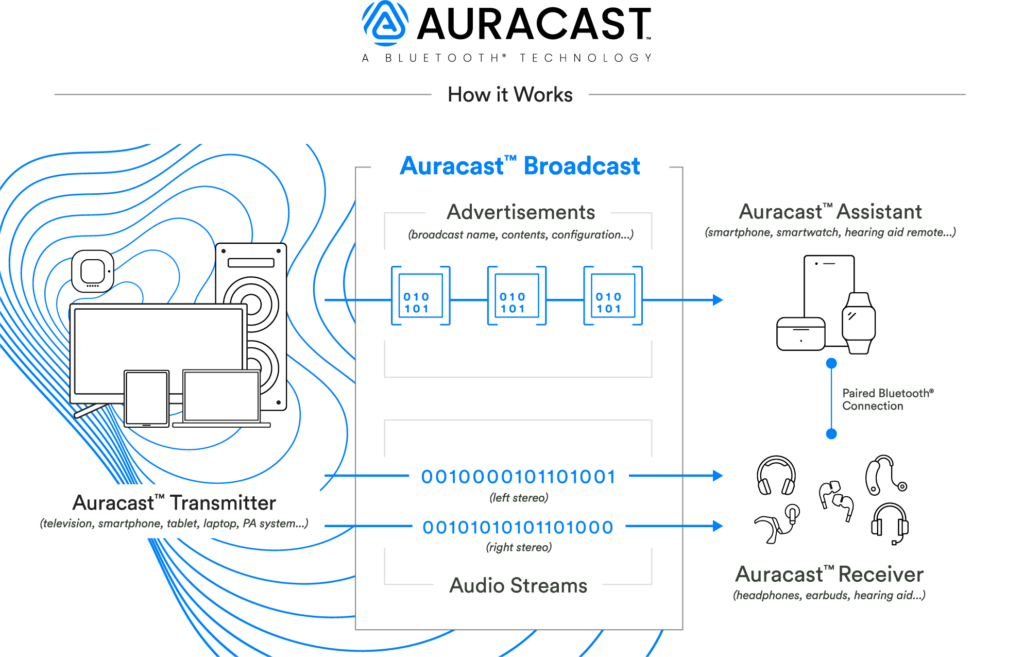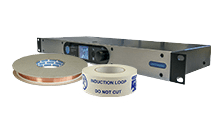Auracast™ may be an unfamiliar term to many but it is quickly starting to appear in the headline features of new Bluetooth enabled devices, such as phones, earbuds, portable speakers, hearing aids and cochlear implants.

Most people are very familiar with Bluetooth audio, generally this is two devices pairing directly with one another, for instance a phone connecting to wireless headphones. This works well for many applications, but as well as it being a one-to-one connection there are several other limitations that have made the previous Bluetooth standards inappropriate for assistive listening applications. These include relatively high battery usage, limited range, and levels of latency that result in audible echo, or visible lip sync issues when listening to live sounds. Because of these factors the hearing aid industry has been working with the Bluetooth Special Interest Group since 2013 to develop the next generation of Bluetooth audio.
The result of this is the latest Bluetooth Low Energy Audio specifications which aim to address many of the previous shortfalls, and within that a feature called Auracast™, which is a brand-new capability for Bluetooth, broadcast audio. This is the ability to send a signal from one transmitter to an unlimited number of receivers.
These features are likely to be available in most Bluetooth enabled audio devices in the future, but at the start of 2024 it is still in the early announcements phase and there are very few products available to purchase right now which support these new standards.
Some products will receive software updates that bring compatibility, but in many cases, it will only be added in newer models. It takes time for new technology to filter down from higher end models and to be adopted by providers like the NHS, so taking this into account, alongside the typical 3-to-7-year lifespan of a hearing aid, it will be many years before everyone has access to these new features.
So, what tangible benefit will this bring to people with hearing loss? To start with, this offers improvements for existing Bluetooth audio use cases, batteries will last longer and audio will be more in time with acoustic sounds, but most importantly it opens up whole new applications which haven’t been possible until now.
One of the use cases likely to drive adoption of Auracast is assistive listening in public spaces. This promises a future where environments such as theatres, meeting and teaching spaces, airports and many more will have broadcast Bluetooth streams where people can directly connect with their own phones, earbuds, hearing aids or cochlear implants. Ampetronic and Listen Technologies have already announced and demonstrated Auri™, a complete end to end Auracast based assistive listening system, which will be released shortly.

This system uses an installed transmitter to broadcast audio over a large area, potentially over 100m metres range. Importantly it also has very low latency, as little as 30 milliseconds which is imperceptible when listening to speech, the equivalent of being stood around 9 metres away from the sound source.
As end user devices are limited right now, expect the first assistive listening systems to be largely receiver based. These will therefore be a similar user experience to something like an infrared system where a user will pick up a dedicated receiver with headphones or a neckloop from the front desk. Over time however, as more end users have compatible devices, people will be able to connect directly to the venue sound, making the user experience more similar to using an induction loop with a telecoil enabled hearing aid.
There are also a few questions to be answered before these systems become quite as easy to use as a hearing loop, which is often a single button press or a preset selection on the hearing aid. Connecting to an Auracast™ system in most cases will need an “assistant”, typically a mobile phone, which can scan, list available streams and then tell the hearing aid which stream the user wishes to connect to. This “assistant” is required as unlike hearing loops there may be several different channels of audio available in the same space, potentially other languages, audio description, sound from multiple TV screens, or unrelated broadcasts from other people’s phones or laptops. Because of this it is important that users have a method to ensure they connect to the correct audio stream.
In more private or sensitive environments such as cinemas, board rooms or courts the broadcasts may be protected with encryption, in which case a password is needed. This can be entered through the phone in a similar way to connecting to a public Wi-Fi hotspot, or it may be provided via a QR code or other means.
One important point to note is that all this functionality will either be built natively into the phone’s Bluetooth settings, or it will be driven from the app you already use to manage your hearing aids, so no proprietary, third party or venue specific apps will be needed.
Once a market saturation point is reached, likely in a decade or more, it is expected that Auracast will surpass all of the existing assistive listening technologies, but there is a long transitional period before that point. During this transitional period the Bluetooth SIG themselves state the importance of this co-existing with other assistive listening technologies, in particular hearing loops, such that the large user base of people with telecoil enabled hearing aids are not disenfranchised by a wholesale change to a new technology. A venue with both hearing loop and Auracast systems installed is best placed to provide truly accessible audio during this transition of technologies.
There is certainly huge potential for Auracast™ to change how we all benefit from wireless audio, but right now this is one of several options that each have pros and cons depending on the given venue, application and practical installation considerations.
If you have any questions or would like any more information about Auracast™ Broadcast Overview please contact us on +44 (0) 1636 610062 or email sales@ampetronic.com
“The Bluetooth® word mark and logos are registered trademarks owned by Bluetooth SIG, Inc. The Auracast™ word mark and logos are trademarks owned by Bluetooth SIG, Inc. Any use of such marks by Ampetronic is under license. Other trademarks and trade names are those of their respective owners.”


